Introduction: Welcoming Wildlife to Your Garden
There’s something truly magical about watching a flurry of feathers descend upon your garden, especially as the seasons shift and the natural world adapts. In the UK, our gardens become sanctuaries for a wonderful array of wild birds, many of whom rely on us for a helping hand throughout the year. Feeding garden birds isn’t just an enjoyable family pastime; it’s also a vital way to support local wildlife as they navigate the challenges brought by each season. From the hungry fledglings of spring to the resilient robins seeking nourishment in winter, understanding what to offer and when can make all the difference to their survival and well-being. Just as our gardens bloom and rest with nature’s rhythm, so too do the needs of our feathered friends change—inviting us to tune in, adapt, and nurture the life that shares our outdoor spaces. Let this seasonal guide inspire you and your little ones to create a haven that welcomes birds all year round, fostering connections with nature that will last a lifetime.
Spring: Encouraging Nesting and New Life
As spring unfolds across the UK, gardens come alive with the cheerful chorus of birds preparing to nest and raise their young. This is a magical season for families to connect with nature, as parent birds work tirelessly to find suitable food for their chicks. Supporting these feathered friends during this busy time can have a real impact on their survival and well-being.
High-Protein Foods for Nesting Birds
During spring, birds need extra protein to build nests, lay eggs, and feed their rapidly growing fledglings. It’s important to offer high-protein foods that mimic what they’d naturally find, such as insects and larvae. Here are some excellent choices:
| Recommended Food | Benefits | How to Offer |
|---|---|---|
| Mealworms (live or dried) | Rich in protein; easy for chicks to digest | Scatter on bird tables or in shallow dishes |
| Soaked sultanas/raisins | Soft texture; hydrating snack for young birds | Saturate in water before placing out |
| Sunflower hearts | No shells; quick energy source for busy parents | Add to feeders or sprinkle on the ground |
| Peanut granules (unsalted) | Crushed for safety; high in fat & protein | Offer finely chopped only—never whole peanuts for chicks! |
| Fat balls (no mesh netting) | Sustained energy; suitable for cooler spring days | Use purpose-made holders to avoid entanglement risk |
What to Avoid Feeding in Spring
Certain common foods can be dangerous at this delicate stage. To keep baby birds safe:
- Avoid whole peanuts and large chunks of bread: These can choke young birds or cause digestive issues.
- No dry hard foods: Foods like dry dog biscuits or uncooked rice can expand and harm nestlings.
- Avoid milk: Birds cannot digest dairy products, which can make them ill.
- No salty or seasoned leftovers: Salt is toxic to birds, especially tiny chicks.
Nurturing Nature Together: A Family Tradition
This season, invite your children outdoors to watch hungry fledglings fluttering around your feeders—a living lesson in caring for all creatures. By providing the right foods at the right time, you’re helping local bird families thrive while sowing seeds of kindness and curiosity in your own little ones. Let your garden become a safe haven where new life takes flight!

3. Summer: Hydration and Energy Boosts
As the British summer brings longer days and often drier spells, our garden birds face new challenges in keeping cool and hydrated. It’s a wonderful season for children to observe bustling birdlife and learn how we can lend a helping hand. Here’s how you can support your feathered friends through these warmer months, inspired by nature’s own wisdom.
Water is Essential: Quenching Thirst and Bathing
During summer, natural water sources may dry up, making it crucial to provide fresh water in your garden. A shallow bird bath or even a large plant saucer filled with clean water will do wonders. Place it somewhere shady if possible, and change the water daily to keep it fresh. Watching robins and blackbirds splashing about can spark joyful conversations with children about the importance of hydration—for both plants and birds!
Tip:
Add a few pebbles to your bird bath so smaller birds have somewhere safe to perch while they drink or bathe.
Summer Feeds: Light but Nutritious
While birds have more natural food in summer, extra snacks are still welcomed—especially during heatwaves or if parents are busy feeding chicks. Offer energy-boosting foods like soaked sultanas, raisins, chopped apples, mealworms, and sunflower hearts. Avoid using peanuts or suet in hot weather as these can spoil quickly, attracting unwanted pests and causing harm to birds.
Encourage Curiosity:
Let children help prepare fruit treats or sprinkle seeds among the flower beds. Ask them what fruits they think local birds might enjoy, turning snack time into an interactive learning moment.
Cleanliness Counts: Keeping Feeders Safe
Warm weather encourages bacteria growth, so it’s especially important to keep feeders clean. Wash feeders with hot soapy water every week and let them dry thoroughly before refilling. Remind little helpers that just as we wash our hands before eating, birds need clean spaces to feed too!
Nature’s Lesson:
Show children how regular cleaning keeps their own plant pots healthy—drawing connections between caring for wildlife and tending to the garden together.
4. Autumn: Preparing for the Colder Months
As the leaves begin their golden descent and the air turns crisp, autumn signals a vital time for our feathered friends across the UK. Birds must build up fat reserves to see them through the chillier days ahead, so what we offer at our garden tables becomes all the more important. Think of your bird table as a warm kitchen, inviting tired travellers and local residents alike for a hearty meal.
Fat-Rich Foods: Nature’s Fuel for Winter
In autumn, birds need energy-dense foods that help them store fat. Here are some British favourites and how best to serve them:
| Food Type | Why It’s Good | How to Offer |
|---|---|---|
| Suet Blocks & Balls | Packed with fats essential for warmth and energy | Hang from feeders or place in wire cages; safe from rain if possible |
| Peanuts (unsalted) | High in oil and protein; loved by tits and woodpeckers | Use mesh feeders to prevent choking hazards for smaller birds |
| Sunflower Hearts & Seeds | A favourite with finches; rich in healthy oils | Add to seed mixes or scatter on trays/platforms |
| Dried Mealworms | A great source of protein for robins and blackbirds | Saturate in water first or mix with softer foods |
| Fruit (e.g., apples, pears) | Naturally sweet; provides vitamins as well as moisture | Chop into small pieces and leave on ground feeders or bird tables |
Migrants and Regular Visitors: Who’s Coming to Tea?
Autumn is also when migration patterns stir up excitement in UK gardens. As Scandinavian redwings and fieldfares join our resident robins and blue tits, your feeding station becomes a bustling community hub. Keep an eye out for starlings gathering in murmurations before dusk—a truly magical sight that reminds us of nature’s rhythms.
Together in the Garden: A Family Invitation
This season, invite children to help fill feeders and spot new arrivals. Chat about where these birds might have travelled from, connecting little ones to a wider world. Just as trees shed old leaves to prepare for new growth, autumn teaches us about letting go and getting ready—both in the garden and in life.
5. Winter: Sustenance Through the Frost
As winter’s chill sweeps across British gardens, our feathered friends face their toughest test. With frosty mornings and frozen ground, natural food becomes scarce—and here, we can offer a lifeline from our own back doors.
High-Energy Foods to Warm the Wings
During these cold months, birds need extra energy to keep warm. Fat balls, suet cakes, and peanut butter (unsalted and bird-safe) are real winter winners. You can also put out sunflower hearts, crushed peanuts, and mealworms. These treats are packed with calories and will help robins, blue tits, blackbirds, and wrens stay active through even the harshest frost.
Feeder Placement: Shelter from the Storm
Winter winds can be biting, so place feeders in sheltered spots—near hedges, shrubs, or fences. This helps shield birds from icy gusts and predators alike. Try hanging feeders under tree canopies or next to evergreen bushes; these natural umbrellas provide protection while still offering birds a clear view of their surroundings.
A Welcoming Garden When Nature Sleeps
When berries have been picked clean and insects are hiding away, your garden can become a winter haven. Keep birdbaths ice-free by floating a small ball on the surface or pouring on warm water in the morning. Scatter food on tables as well as in hanging feeders, so ground-feeding species like dunnocks and robins can join the feast. If you’re gardening with children, let them help refill feeders or create homemade fat balls—it’s a brilliant way to learn about nature’s needs during the colder months and nurture kindness for all creatures great and small.
6. Best Practices: Keeping Birds and Gardens Healthy
Essential Hygiene Tips for Bird Care
Maintaining good hygiene in your garden is vital for the health of both birds and your family. Regularly clean bird feeders, tables, and water baths using hot water and a mild disinfectant to prevent the spread of disease. Always rinse thoroughly and allow items to dry before refilling. Encourage children to wash their hands after helping with bird care—a simple act that fosters responsibility and keeps everyone healthy.
Choosing the Right Feeders
Selecting appropriate feeders for different types of food ensures that a variety of birds can visit safely. Use sturdy seed feeders for small seeds, mesh feeders for peanuts, and platform or ground feeders for larger species like blackbirds and robins. Make sure feeders are placed in sheltered spots, away from predators such as cats, and regularly check for damage or blockage, especially during wet UK winters.
Fostering Family and Community Involvement
Bird feeding is a wonderful way to connect generations and neighbours. Involve children by giving them age-appropriate tasks, like refilling feeders or spotting new visitors in a nature diary. Join local wildlife groups or community garden projects to share tips, swap stories, and collectively look after your feathered friends. By working together across seasons, families and communities can create havens that support both local wildlife and lasting relationships.
Final Thoughts: A Nurturing Tradition
Embracing best practices in bird care not only keeps our gardens lively but also teaches children empathy and respect for nature’s rhythms. Through mindful actions—cleaning, choosing suitable feeders, and connecting with others—we ensure British birds thrive all year round while weaving a little more magic into our daily lives.


